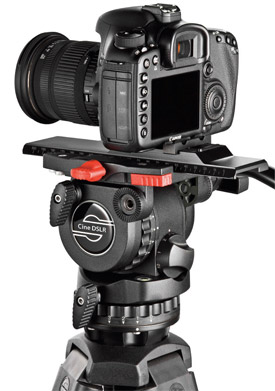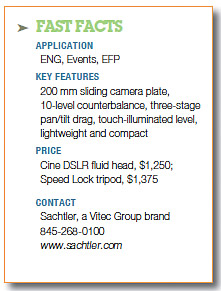Sachtler Cine DSLR Fluid Head, Speed Lock Tripod

Sachtler Cine DSLR fl uid head and Canon camera
Now that DSLRs have created a new "smaller can be better" paradigm for professional HD production, a greater variety of smaller tripods are becoming available to match pro cameras. Some of them include design features for a particular family of cameras, and Sachtler's Cine DSLR fluid head is a prime example. It's very similar to existing models made for small- to medium-sized camcorders, but incorporates features designed especially for DSLR HD capture.
FEATURES
As with other members of what was originally Sachtler's DV line of smaller fluid heads, the Cine DSLR is fairly light, weighing only 4.4 pounds. Its fist-sized 75 mm leveling ball can be locked down quickly and securely with Sachtler's long tie-downs which are easy to tighten. The head size is equivalent to various 75 mm bowl models that go back to the company's DV line of fluid heads and forward to their new Ace line. As with the Aces, the Cine DSLR has three-stage panning and tilting (slow, medium, fast).
The Cine DSLR's payload ranges from 1 to 11 pounds, accommodating the smallest DSLRs, as well as large, fully accessorized units with heavy lenses. In order to do this, the Cine DSLR has an exceptionally long 8.5-inch mounting plate. This provides several inches of adjustment, either forward or backward, to counterbalance various DSLR and lens combinations. Also, there's a three-inch slot in the center of the camera plate for additional horizontal adjustment. The unit's elongated camera plate is engineered to offset weight imbalances when heavy lenses are used with lightweight DSLRs. Plate-mounted cameras are held securely via a sturdy thumbscrew and locking lever. Removal is accomplished by loosening the thumbscrew and depressing a red locking lever. This two-step operation helps to prevent accidentally dumping your prize camera and lens.
The Cine DSLR also features a 10-step counterbalance system designed to prevent the head from moving through its range of movement when not locked or held down.
The Cine DSLR is packaged with Sachtler's Speed Lock carbon fiber tripod, which takes its name from the speed at which the legs may be locked or unlocked with a simple twist of the thumb. It provides a very solid shooting platform, even when used with a front-heavy DSLR and lens.
IN USE
Initially, I attached the head's camera plate directly to the base of the Canon 7D which was mated with an EF 100-400 mm lens. This arrangement worked surprisingly well, even with the lens fully extended to its maximum focal length. I was able to slide the camera backwards at least five inches by mounting it as far back on the camera plate as possible, and then locking the plate as far back on the head as it would go.
To move around comfortably and safely with this seemingly unbalanced load, the next order of business was to set the counterbalance. This keeps the camera pointed ahead and ready for use when not being handled, and is especially important when camera and tripod are being moved around on one's shoulder.
The Cine DSLR is no poor cousin when it comes to counterbalancing. It has 10 distinct counterbalance levels, just like many of its pricier relatives. (The procedure for setting the counterbalance correctly is spelled out quite simply in the user guide.) The key thing to remember is to set the tilt drag level to zero, so as not to add in any drag resistance when you're seeking the perfect balance point. For the Canon 7D and the 100-400 mm lens that I used, a setting of 3 or 4 proved to be the minimum workable level. A setting of 5 or 6 worked better for me, depending on the focal length of the lens. This was especially true when I was moving around with the Cine DSLR on my shoulder. Adjustments to 7 or greater provided even less camera movement, but I found that with the higher adjustment levels, it was tougher to tilt smoothly without changing the drag level or readjusting the balance point of the camera plate. Five or 6 seemed to provide the perfect "middle ground" between camera security and functionality with the Canon 7D and 100-400 mm lens combo. This is as you might expect with a tripod that's designed especially for DSLRs. However, higher levels (7 or 8) seemed to be best suited for "running and gunning" operations.
The head allows several different camera mounting methods, depending on whether you elect to attach the camera plate to the lens or to the base of the camera. I used the Varavon Pro Finder, a relatively recent development. Although it took a bit of experimentation, I was able to find the perfect position for the sliding shim on the tripod plate adapter to attach the 7D camera and Pro Finder combo. This involved locating the exact position for camera, finder, camera plate and shim to achieve a solid and functional fit. The head's designers obviously did their homework, as I was able to hit the perfect combination after just a little trial and error.
The Cine DSLR meets Sachtler's high standards despite only three levels of pan and tilt drag. These seem to correspond to low, medium and high drag levels on 5 and 7-stage Sachtler fluid heads that I've used. However, this didn't stop me from getting amazingly smooth pans and tilts.
I found the illuminated level to be another cool feature of the Cine DSLR, as it meant that I didn't need a flashlight and batteries.
In connection with the tripod, the feature that I loved most was the locking lever on the legs. This enabled me to easily adjust leg length while shooting, with no effort at all. This tripod also compresses into a very compact transportable package, which was very handy during a transcontinental flight. I was able to take it on-board along with my camera package as a carry-on item. This was the first time I was able to travel with a tripod without having to check it as baggage.
SUMMARY
Sachtler's Cine DSLR fluid head is a variation on their time-tested fluid head technology, and is specially optimized for use with DSLR cameras and long lenses in video applications. It is smartly designed for smooth tripod-based camera moves and provides Sachtler's traditional toughness and dependability. Its 10 counterbalance levels and leg locking levers are easily adjusted in the field. Although it's designed especially for DSLRs, the Cine DSLR fluid head works perfectly well with small to medium video cameras, and offers stable and rugged support for ENG and event use. It provides the sort of quality and dependability that also makes it a perfect choice for many EFP apps, especially those involving DSLRs and the new generation of small HD cameras with large sensors.
Carl Mrozek operates Eagle Eye Media, based in Buffalo, N.Y., which specializes in wildlife and outdoor subjects. Contact him at eagleye11@gmail.com.

The professional video industry's #1 source for news, trends and product and tech information. Sign up below.
